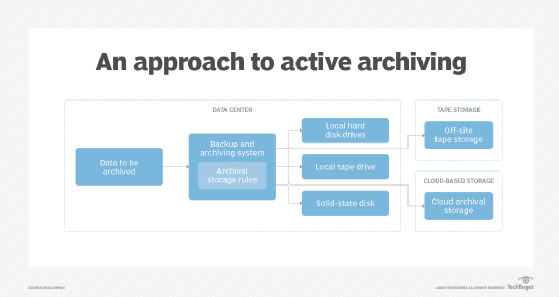
Artur Marciniec - Fotolia
How can I best implement an active archive environment?
Examine the major elements of an active archiving environment, including the kinds of data that you can use in one and resources to help with platform execution.
Archiving assumes an organization must protect data but might not actively use it for an extended period. Typical archiving technologies include magnetic tape and cloud-based archives.
However, suppose certain data has significant value to an organization, and its active use may be intermittent. Active archiving enables organizations to occasionally use important data when necessary -- for example, when a court subpoenas data as part of a case or other litigation involving the firm that possesses the data.
How to create your active archive platform
First, determine what data fits into the category of "occasional" usage. Your organization might define this in a data protection policy document, which should address archiving requirements. Typical candidates for an active archive environment include unstructured data such as user files, videos, audio files and PDFs -- in short, daily operational business information data not contained in a database.
Next, examine the backup and storage resources available that could support the movement of data across different storage media, such as solid-state drives, hard disk drives, magnetic tape, optical disk and cloud-based storage facilities.
Regardless of the archiving approach, your organization should classify data according to various metrics as defined in a data management policy. In addition, authorized individuals should have easy access to that data in a controlled fashion. The data should be easy to locate and extract from the storage medium and stored in a secure manner that optimizes its value to the organization. The data protection policy should also outline each of these parameters, including metrics for storage, recovery, retention and destruction.
Consider different approaches for configuring storage resources to accommodate the variability and flexibility of your active archive environment. You can configure a storage environment with suitable archiving technology to archive data to a variety of media -- either local or off site -- based on retention and retrieval parameters defined by users.

An active archive environment example
You most likely use local hard drives for day-to-day business transactions. You could assign the solid-state drive as the "short-term archiving" resource because your organization can quickly retrieve data as needed from such devices. You might assign the local tape drive to "medium-term" storage, since data access from tape takes longer than with other technologies. You can move the storage location for archived data based on changes to your archiving rules, such as a change in the frequency of data use.
Cloud storage resources can support short-, medium- and long-term archiving requirements. They can also rotate with local archival storage technology to provide a strong, active archive environment. Off-site tape storage works best for much longer-term archiving requirements.
The backup and archiving system -- and the archiving rules -- should determine where to locate data, based on the business need.
An active archive environment is another important tool for organizations that have flexible requirements for archival storage of data.





